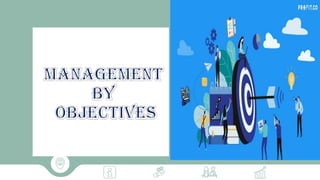MBO.pdf
•
0 likes•9 views
Management by objectives (MBO) is a strategic management approach where employees and employers jointly set goals, define individual responsibilities, and use performance measures to evaluate contributions. The process involves establishing organizational goals based on the company's mission and vision. Individual employee objectives are then defined considering their abilities. Managers continuously monitor performance, provide feedback, and conduct evaluations to improve scope and spot weaknesses. The goal is to review performance regularly and improve efficiency.
Report
Share
Report
Share
Download to read offline

Recommended
More Related Content
Similar to MBO.pdf
Similar to MBO.pdf (20)
Career & Talent Management in Unilever Bangladesh Ltd.

Career & Talent Management in Unilever Bangladesh Ltd.
Human Resource Management - G.O.L TEAM by Mr. Sherif Osman 

Human Resource Management - G.O.L TEAM by Mr. Sherif Osman
More from PiryaHussain
More from PiryaHussain (7)
PARTS OFSPEECH POWERPOINT PRESENTATION ACTIVITY.pdf

PARTS OFSPEECH POWERPOINT PRESENTATION ACTIVITY.pdf
Recently uploaded
Recently uploaded (11)
Leading People - Harvard Manage Mentor Certificate

Leading People - Harvard Manage Mentor Certificate
Spring-2024-Priesthoods of Augustus Yale Historical Review

Spring-2024-Priesthoods of Augustus Yale Historical Review
W.H.Bender Quote 63 You Must Plan T.O.P Take-Out Packaging

W.H.Bender Quote 63 You Must Plan T.O.P Take-Out Packaging
LECTURE maintenance management is important 1.pptx

LECTURE maintenance management is important 1.pptx
TEST BANK for Operations Management, 14th Edition by William J. Stevenson,.pdf

TEST BANK for Operations Management, 14th Edition by William J. Stevenson,.pdf
Management 13th Edition by Richard L. Daft test bank.docx

Management 13th Edition by Richard L. Daft test bank.docx
DrupalCamp Atlanta 2022 - Effective Project Management

DrupalCamp Atlanta 2022 - Effective Project Management
Marketing Management 16 Global Edition by Philip Kotler test bank.docx

Marketing Management 16 Global Edition by Philip Kotler test bank.docx
Group work -meaning and definitions- Characteristics and Importance

Group work -meaning and definitions- Characteristics and Importance
MBO.pdf
- 1. a
- 2. introduction ❖The term MBO is stands for Management By Objectives. ❖Also known as PRIDE (Performance, Result, Individual, Development and Evolution). ❖It was introduced by Peter Ducker in his book The Practice of Management. a
- 3. DEFINITION It is a strategic and management approach where by the employees and employers come together to identify for common goals, define each individuals the major areas of responsibilities in terms of result expected of him and use those measures to assess the contribution of each employees after the completion of task. a
- 4. a
- 5. Define organizational goals The first step is to establish an organizational goals which evolves from the mission and vision of the company a
- 6. Define employees objective The second step is define goals and objectives of individuals for this opinion is taken from the employees on their ability of goals accomplishment and targets which the set for themselves a
- 7. Continue monitoring progress and performance a The manager needs to continuously monitor the performance of each employee to identify and loopholes or hurdles in business operation
- 8. Performance evolution After completing the monitoring the work, the managers need to evaluate and review the performance of every individual to spot any scope for improvement. a
- 9. Providing feedback With the help of above evolution, the manager now need to give valuable feedback ton every individual motivate them and making them aware of their weakness and potential for improvement a
- 10. Performance appraisal The last step is to reviewing the performance of each employees regulatory to bring efficiency in their work stream a
- 11. Assumption ❖Existence of mutual understanding betweem supervisor and subordinate. ❖Employees can perform better when they clearly known what is expected of them. ❖It assumes that employees are interested in the formulation of plans want to know the result of heir performance and want to be fairly rewarded for their performance a
- 12. Advantages ❖Efficient management and efficient planning ❖Clarity of organizational goals. ❖Facilitate guidance and direction to subordinates and motivates them for achieving goals. ❖Easy to achieve organizational goals. ❖Enhance job satisfaction and develop cordial relationship between supervisor and subordinate a
- 13. Limitations ❖Difficulty of setting goals. ❖Problems of balancing and coordination. ❖Lack of support of top level managers anf excessive pressure on the subordinates. ❖Lack of suitable incentives and reward ❖Time consuming process. a
- 14. a